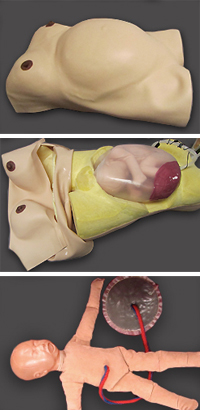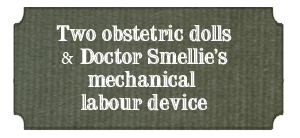INTO THE 21st CENTURY
The use of obstetric simulation models did not end with William Smellie. In Europe subsequent models by Johann Christian Stark and Friedrich Benjamin Osiander appeared in the 18th and 19th centuries, which were in turn further appropriated by later teachers of obstetrics and midwifery.1
High fidelity simulation entered the health-care industry in the late 1980s. Since 1980, health-care disciplines are taking steps towards incorporating simulation into training and evaluation programs. 2 Pamela R. Jeffries et al ⬀ and Roxane Gardner ⬀ both offer comprehensive surveys on contemporary simulator types and clinical simulations for teaching midwifery and obstetrics. These days, ‘machines’ are anatomically correct female mannequins with the capacity to simulate many aspects of labour. In some instances the mannequin mother can be programmed to vomit as well as verbalize pain and anxiety.
Companies such as Anatomical Model ⬀ , Adam-Rouilly ⬀ , and Gaumard ⬀ are but a few examples of makers of modern-day obstetric training devices.
Proponents of these technologies claim that simulators improve students’ confidence, time-management, leadership and critical thinking. They help to identify clinical error, reduce clinical risk, and improve clinical outcomes.3 However, the more true-to-life the simulations become, the more chance there is of perpetuating the presentation of birth as predictable and controllable and as a pathology where birthing women are only passive patients. Medical anthropologists are concerned that using birth simulators reinforces the belief that science and technology prevail over the natural process of a physiological phenomenon. 4 ➡
NOTES | 1. Boschung,1981 --- 2. Gardner 775 --- 3. Nall, 2012 --- 4. NALL, 2012
IMAGES | modern obstetric training models courtesy of Professor Jean Ker, Clinical Skills Centre, University of Dundee | manufactured by Adam Rouilly | photos by Stef Lenk | ⬀ external links

